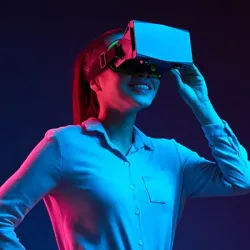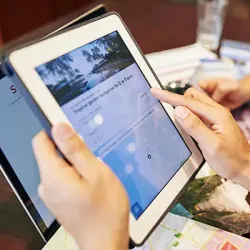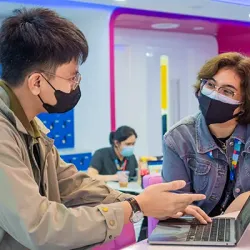Industry Knowledge
Elevating Your Employee Engagement: Why Gamification in Business Matters
Implementing gamification for business brings multiple benefits to employee learning. Learn how it can help boost a workforce’s engagement and motivation.
I love games—board games, video games, team games, card games—you name it! My first game console was the Atari, which was a huge deal back in the day.
Video games have come a long way since Space Invaders and Pong, but the essence remains: games are meant to be fun and engaging. Similarly, they can boost the education and retention of workplace learning. A study completed by the University of Colorado Denver Business School found that using video games in training led to substantial improvements in performance.1 An employee training and development team can use gamification for employee engagement to enhance the corporate training process and continue the workforce’s professional development. This practice or strategy is called gamification in business.
Buffs and Benefits of Gamification in Business

Employee gamification is about applying gaming strategies to improve learning and make it more engaging for individuals working for an organization. Just as Mary Poppins tells us, having fun at work makes the job more enjoyable and brings added benefits. Gamification increases learner motivation, improves knowledge retention, and allows for better learner engagement.
So why gamify work? Anyone who has watched a friend or partner shout at the television or computer monitor while playing an online game can attest that video games can bring out emotion in people. I recall celebrating with shouts and hugs when my brother and I finally beat the last level of a particularly challenging game. In the same way, applying gamification for employee engagement creates an emotional connection between the learner and the content, increasing the learner’s attention toward the material and allowing the learner to be more motivated to learn the subject matter.
Gamification in Talent Development: A Scientific Perspective
A chemical change occurs in a learner’s brain when games are used within a learning course, such as in implementing gamification to improve employee engagement. Endorphins are naturally produced and released in the bloodstream. Endorphins improve relaxation, calm, and focus, helping the learner focus on the material. In addition, dopamine is removed from the hippocampus, allowing additional focus and better recall of the material after the learning course.
Gamification in business training contains the Three E’s of Learning: Educational, Engaging, and Entertaining. In a recent report by Gallup, engaged employees “doubled their odds of success” compared to disengaged employees.2 Thus, organizations need to implement gamification as early as the new hire experience. But how do you gamify workplace? Let’s look at some gamification examples for employee engagement:
- Recognition
One way to motivate and engage employees is to ensure they are recognized for their achievements. Implementing this on social media will make it more visible and interactive, allowing other employees to react and congratulate their peers and helping build a stronger sense of community and support within the organization.
- Goal Tracking
Another way to motivate employees and increase productivity is to set goal trackers. A visual representation of each person’s accumulated accomplishments can bring a sense of confidence, purpose, and progress.
- Leaderboards
Friendly competition will always be an excellent tool for encouragement and engagement, such as having a visible leaderboard to motivate people to do better. It also allows the organization to identify its top performers. When employees are segregated into teams, leaderboards can help create synergy and teamwork amongst the workforce.
- Reward Programs
Sometimes, recognition alone isn’t enough. Run a rewards program for those who’ve topped the leaderboards or dominated the goal trackers. Gift them travel packages, monetary bonuses, or even open positions within the organization. You can also implement a point system and have corresponding prizes for each level of completion.
Gamification in business brings many benefits that help improve the learning process for all kinds of learners. Now that we understand what gamification for employee engagement is and how it is helpful within training and development, how can you add it to your training courses? How can you turn your current curriculum into a game? These are a few questions you’ll need to figure out to win.
Win with Us
Winning is much easier with a player two you can trust. Utilizing employee gamification is just one aspect. Finding a proven and equipped partner to help you deal with all the challenges of the talent management lifecycle— employee training, development, and retention—is crucial if you plan to stay competitive.
If you love to win, then we’d love to be your wingman. Recognized by the Everest Group as the World’s Fastest Business Process (outsourcing) Service Provider, TaskUs is always ready and more than capable of providing effective talent management. We have brought positive change within and outside our organization by delivering world-class solutions, increasing client satisfaction, and enhancing employee experiences for over a decade in the outsourcing industry.
References

We exist to empower people to deliver Ridiculously Good innovation to the world’s best companies.
Useful Links












